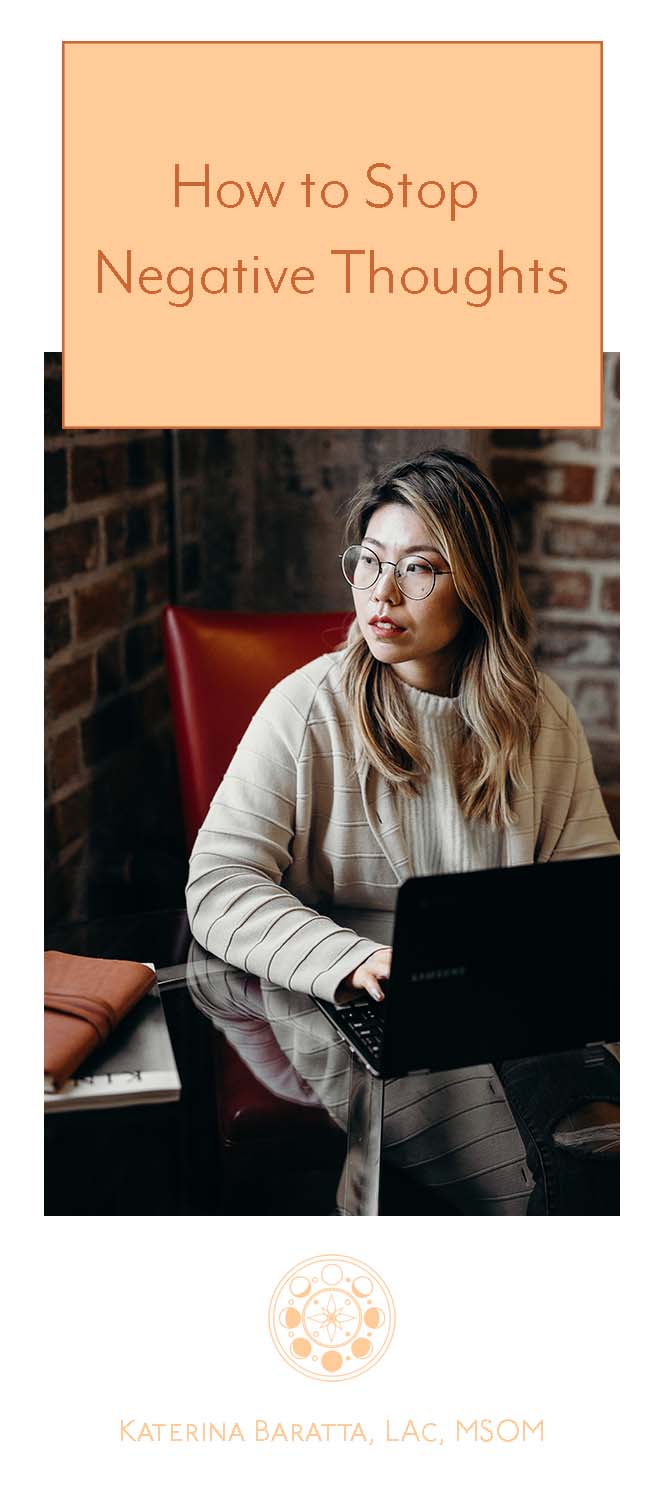Negative thoughts are, by definition, a huge bummer.
They literally dictate how you feel.
And what’s worse is that most of the time you don’t have any control over them.
There you are, all happy-go-lucky, minding your own beeswax, and BAM!
In prances a negative thought like it owns the place.
But not just one negative thought (no, they never travel alone).
Now there’s a whole parade of negative thoughts swarming into your mind.
And for some reason, your mind wants to follow their lead.
Before you know it, off your mind goes, following that negative thought parade all the way down a negativity tunnel and you can’t find your way out.
But there’s light to be found in the darkness, my friend.
Because all you need to do to stop negative thoughts is to is turn that negative thought parade around.
The technique I’m about to teach you was shown to me a few years ago by Byron Katie, and has helped me (and let’s get real, MILLIONS of other people) transform negative thoughts into a more positive mindset.
And it’s amazing, because you really don’t have to do much at all in order to feel (almost instant) relief.
Once you turn your negative thoughts around, the feelings take care of themselves.
So, what’s the secret, you ask?
Simple.
Question your thoughts, then turn them around.
Let’s break it down.

Thoughts are just interpretations of reality.
They are the result of your mind trying to organize the world around you so you can navigate it in a safe way.
But all too often this safety mechanism goes into overdrive and you find yourself with negative thought patterns that don’t serve you at all.
These patterns get stuck in your actual neurology.
As in, the neurons in your brain get wired on a physical level to repeat these negative thought patterns.
Because your brain is lazy, and if something’s happened before, sometimes it’s just easier to go down the same familiar route again instead of putting in the energy to try something new.
But luckily, your neurology is plastic.
(That’s just a fancy way of saying it’s flexible and can change.)
Basically, the more you think a thought, the easier it becomes to think that thought, and the more likely you are to think that or a similar thought in the future.
If the thoughts you are thinking don’t make you feel good and cause you stress or anxiety, then you’ve just got to train your thoughts in another direction.
So the first step is to observe your thoughts.
Because if you don’t realize you’re having a negative thought, you really have nothing to work with.
You can do this through meditation, mindfulness, journaling, and similar practices.
Once you know how to observe your thoughts and how they make you feel, you can easily identify which thoughts aren’t serving you.
Then, the second step is to question your thoughts.
The simple practice of questioning your thoughts takes the power out of your thoughts.
And even better?
It makes room in your mind for a new reality.
Because again, your thoughts are just your mind’s interpretations of the world.
They might feel real, sure.
But there are about 10 kajillion other ways to see and experience your life that are totally different but just as real.

Your thoughts are WAY more powerful than you probably realize.
And you have WAY more power to change your thoughts than you probably realize.
But it takes practice.
Let’s start with an example.
Let’s say you’ve just gotten the 9th rejection letter from a series of jobs you’ve interviewed for and were really hoping to get.
Now, there’s obviously a lot to feel negative about in this situation.
You’re starting to feel kind of hopeless, and more than a little bit down on yourself.
There are a lot of negative thoughts going through your mind at this point, but you just want to choose the most dominant one to start.
Maybe the thought that you’re thinking the most at this point is: “I’m never going to get a job I like.”
Now that you have it, you can start to question it.
Ask yourself, “Is this true?”
The answer here would be, “Well, maybe. But it’s highly unlikely.”
On to the next question: “Can I absolutely know that it’s true?”
The answer to this is obviously “no,” because you can’t predict the future any more than you can walk through walls.
(I know, forgive me. I’m making an assumption about your abilities here, but so far I haven’t come across too many people with supernatural abilities reading my work. Feel free to correct me if I’m wrong.)
Next, ask yourself how it feels when you think this thought.
Where do you feel it in your body?
What does it feel like?
What metaphors or images come to mind when you think this thought?
Maybe it feels like a knot in your stomach, a ton of bricks on your chest, or a buzzing on your skin.
Maybe you feel like you’re standing in front of a big wall, or drowning in a turbid ocean.
Do you have any other associations, like memories, sounds, smells, or anything else that comes along with this thought?
Just notice anything you feel.
Once you’ve got that, continue your investigation by imagining how you’d feel without this thought.
Who would you be without this thought?
What would your life be like?
How would you respond to things?
And then comes the turnaround.
You turn negative thoughts around by finding an opposite thought and at least 2 true statements to support it.
Here you might simply tell yourself, “I’m going to get a job I like.”
And the supporting statements might be something like:
“Good things often take time.”
“New opportunities are always presenting themselves.”
And “I cannot predict the future any more than I can walk through walls, so good things are just as likely to happen as things I perceive to be unfavorable.”
Once you’ve turned one statement around, you can move onto another one.
Let’s keep going with this example.
In this case, maybe you keep hearing your mind say “I’m worthless.”
Step one is to observe your thought (check!).

The next step is to question your thought:
- Is this really true?
- Can I absolutely know this is true?
- What does it feel like in my body when I think this thought?
- What would my life be/what would I be without this thought?
And then to turn this around, you’d simply want to say “I’m worthy.”
Then you need to find at least 2 supporting statements (that you know are true) to back this up.
Here you might say: “I’ve gotten jobs before that I’ve excelled in, so I’m clearly worthy.”
Or: “I am really good at X, Y, and Z.”
And maybe also: “My worthiness isn’t tied up in whether or not I get a job.”
You could go even further and tell yourself: “I believe that every person on earth is worthy of love and happiness, simply for being alive, and that includes me.”
The key here is to make sure you believe what you’re saying, so find supporting statements that ring true to you.
Trust me, they’re there.
Even if it takes a moment to find them in the darkness.
Byron Katie calls these questions and turnarounds “The Work”.
And in addition to some really mind-blowingly awesome books, she also gives totally free guidance online to anyone who wants it.
Another thing that can help you turn negative thoughts around are mindset-shifting mantras.
These are simple phrases that you can switch to anytime your most persistent negative thought patterns decide to make an unwelcome appearance in your mind.
And they’re especially useful to have on hand when you don’t have time to sit down and do the work, but still need to turn yourself our of the darkness of that negativity tunnel.
I have a (free) printable PDF guide that you can pin on your refrigerator or stick in your wallet so you always have another perspective on hand when you need it.
Click here to download it now.
And then I’d love to hear from you.
What negative thought patterns are most persistent in your mind?
Leave a comment, because your experience is sure to help someone else!
I can’t wait to see where this takes you.
xoKaterina





